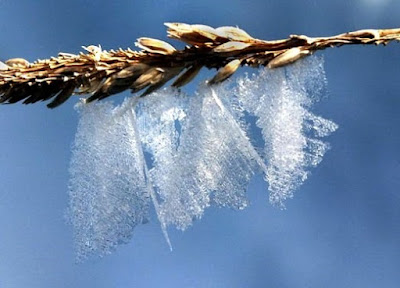By Yvette Henson
Have you ever been driving, say along a river, in the winter, in the first light of day and noticed that each leaf and every branch on the plants are covered in a glistening coat of frost? I remember such a scene when I had my grandmother with me. She commented on how beautiful the hoar frost was. Even though I had never heard the term ‘hoar frost’, I agreed.
 |
| frost coated plants in a landscape Pixabay photo |
Hoar frost occurs on exposed plants near unfrozen bodies of water (like a river valley). It forms on very cold, clear nights when the air contains enough water vapor to condense and freeze. It forms complex interlocking frost crystals on plants and other surfaces it contacts. These crystals can be quite large and showy and form many different shapes. It usually melts not long after the sun comes out but it is spectacular while it lasts and is worth looking up close!
 |
| Hoar frost on a grass inflorescence http://snowcrystals.com/ |
Another beautiful form of hoar frost is surface hoar, the sparkling crystals, often called ‘diamond dust’, that forms on the surface of snow. When the surface of the snow warms up during the day and then the night temperatures drop below freezing, the surface of the snow becomes colder than the snow beneath the surface. Water vapor evaporates to form the dazzling frost crystals on the surface. These crystals also disappear when the sun shines on the surface of the snow.
 |
| Diamond dust on snow pixabay photo |
Rime is a different type of frost that occurs on cloudy nights when snow crystals encounter water droplets in clouds of fog near the ground. If the water droplets in the fog are supercooled below the freezing point, the droplets freeze on contact to anything they touch. Rime crystals are simpler and more blocky than hoar frost crystals. I think the frost in these pictures is most likely rime but I could be wrong. I noticed these beautiful frosty crystals on a hike in the desert late last winter.
 |
| windowpane frost Pixabay photo |
There are more types of frost and I am not an expert by any means, but I love that if we look around we can find beauty in the bleak winter.





